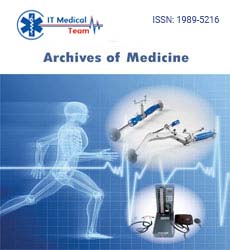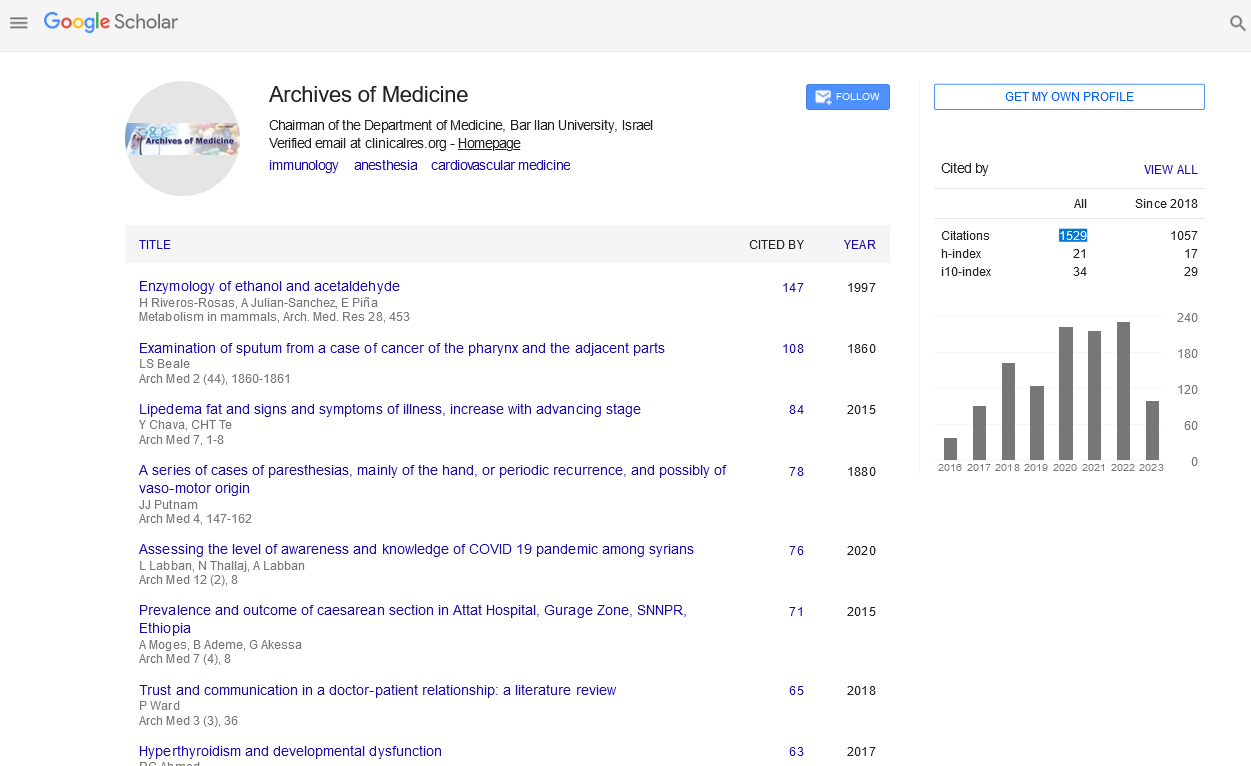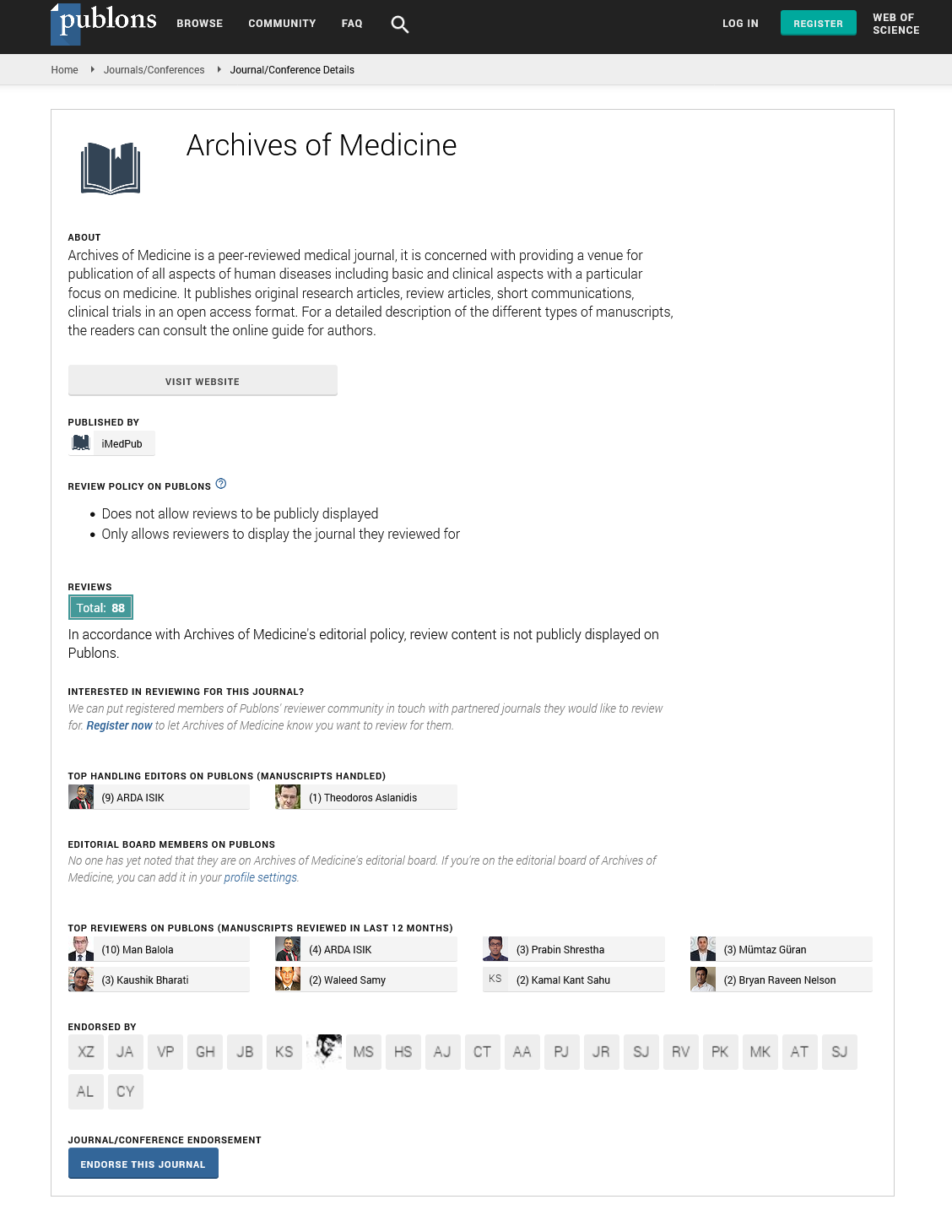Opinion - (2022) Volume 14, Issue 10
Cystic fibrosis molecular targets and the therapeutic potential of monoclonal antibodies
Jennie Khouja*
Department of Preventive Medicine, King Abdullah International Medical Research Center, Jeddah, Saudi Arabia
*Correspondence:
Jennie Khouja, Department of Preventive Medicine, King Abdullah International Medical Research Center, Jeddah,
Saudi Arabia,
Email:
Received: 03-Oct-2022, Manuscript No. ipaom-22-13177;
Editor assigned: 05-Oct-2022, Pre QC No. P-13177;
Reviewed: 19-Oct-2022, QC No. Q-13177;
Revised: 24-Oct-2022, Manuscript No. R-13177;
Published:
30-Oct-2022
INTRODUCTION
The lungs and digestive tracts are both impacted by
the autosomal, progressive genetic illness known as cystic
fibrosis (CF). It is one of the most prevalent fatal autosomal
recessive genetic illnesses among Caucasians, affecting an
estimated 48,000 people in Europe and 30,000 people
in the US. The Gulf region and Saudi Arabia both have
high rates of the illness (CF). Its incidence in the Middle
East is estimated to be 1 in 2000–5800 live births, with
a prevalence of 1 in every 30,000–50,000 live births.
Extrapolating from known cases to the general population,
it has been estimated that 1 in 4243 Saudi Arabian children
and adolescents will have the disease. The gene for the
Cystic Fibrosis Transmembrane Conductance Regulator
(CFTR) produces a protein. This protein functions as a
channel across the cell membrane to control the production
of digestive enzymes, perspiration, saliva, tears, and mucus
[1].
Description
The development of thick and sticky mucus that clogs
the ducts of organs where the CFTR protein is produced is
caused by a mutation in the CFTR gene, which interferes
with the flow of ions into and out of cells. Patients with
CF consequently experience chronic lung infections and
respiratory problems. Additionally, because the CFTR
protein is expressed at numerous locations throughout the
body, its expression is impaired, which leads to a variety of
clinical symptoms. The lungs are the most often impacted
organs by CFTR mutation, despite the fact that the CFTR
protein affects many different body parts. Indeed, in the
United States of America, lung disease is the main factor
contributing to CF-related morbidity and mortality. The
underlying causes of the thick, sticky mucus that is typical of
CF patients include chronic lung inflammation, recurring
infections, and issues with the cystic fibrosis transmembrane
conductance regulator protein. It is believed that cystic
fibrosis contributes to mucociliary dysfunction and airway
dryness, both of which can lead to tonic epithelial sodium
channel (ENaC) activity. Electrogenic sodium absorption
that is amiloride-sensitive is driven by this action. Reducing
ENaC, which reduces sodium absorption, can reverse the
drying up of the airway surface fluids [2].
The CFTR protein typically forms a channel to
transport chloride through the membranes of cells that
line various surfaces in the body, including the surface of
the lung. Chloride is a component of salt. But CF patients are unable to generate this channel. Chloride becomes
trapped inside cells and is unable to draw in the fluids
required to hydrate the cell surface when the protein is
not working properly or when it is absent from the cell
surface. Furthermore, in the absence of a functional CFTR,
the epithelial Na+ channel is also dysregulated. Mucus
obstruction, neutrophilic infiltration, and chronic bacterial
infection are caused by mucus dehydration brought on
by CFTR deficiency and increased ENaC activity. The
outcome is a dehydration of the cell surface. Lack of the
necessary fluids causes mucus to lose its moisture and
thicken. The airways may suffer long-term consequences
from this. One of the main innate immune defence systems
in the respiratory tract, mucociliary clearance, is hampered
by defective ion transport caused by the CFTR gene. The
development of innovative treatments that are logically
crafted to provide a precise, long-lasting suppression of
ENaC activity in the airways while concurrently limiting
off-target fluid transport effects, systemic exposure, and
negative consequences has been the focus of recent study.
There are several approaches, such as oligonucleotidebased
therapies, next-generation small molecules direct
inhibitors, synthetic peptide analogues, and indirect
channel-activating protease inhibitors. It is quite exciting
that the development of ENaC-directed therapeutics for
cystic fibrosis is being advanced by these novel drugs.
Endogenous heterotrimeric ENaC channels are inhibited
by the addition of mutant ENaC mRNA (mutENaC). It
was successful to transfect CF-based airway cells with lipid
nanoparticles carrying the mutENaC mutation both in
vitro and in vivo. Macroscopic ENaC currents significantly
decreased, amiloride-sensitive ENaC currents in CF airway
cells increased, and the liquid height of the airway surface
increased [3].
In treating CF, a palliative strategy is used. In essence,
it aims to improve the patient's quality of life while also
slowing the progression of the illness. The use of long-term
pharmacological therapy is necessary for management
techniques that aim to reduce inflammation, mucus
clearance, and pancreatic enzymes. The need for antibiotics
is crucial since they suppress infection. There is also
a requirement for intensive physical therapy, ongoing
lung function monitoring, and dietary care. The aim of
CF treatment heavily depends on where it developed.
According to the sensitivity patterns of bacteria to the
commonly prescribed antibiotics like azithromycin,
tobramycin, aztreonam, ciprofloxacin, levofloxacin,
cephalexin, amoxicillin, and doxycycline, infections are
often controlled by the development of CF in the lungs.
Utilizing nonsteroidal anti-inflammatory drugs (NSAID),
steroids, and cromolyn to decrease inflammation is also
crucial. Lower airway mucus build-up is a defining feature
of the CF pathogenesis. In CF, pus made of viscous materials
like polymerized DNA acquired from dead neutrophils
serves as the main component of mucus rather than mucin,
which is released by mucus-producing cells. To ensure the
patient's health and freedom of breathing, mucus clearance
from the airway is a crucial treatment strategy. Inhaled
N-acetylcysteine and -agonists with humidified oxygen are
two examples of mucolytic medications that are helpful
in CF. A medication for inhalation called dornase alfa
reduces pulmonary exacerbations brought on by CF and so
enhances lung function. According to reports, CF patients'
lung function was enhanced by hypertonic saline (3-6%).
Oral rehydration, osmotic laxatives, hyperosmolar contrast
enemas, electrolyte intestinal lavage solution, and other
treatments may be used to treat CF that develops in the
gastrointestinal tract (GIT), Depending on the severity of
the aetiology, a diatrizoate sodium and meglumine enema
may be used. For 6 to 12 months, regular oral osmoticlaxative
polyethylene glycol 3350 treatment is utilised to
stop the recurrence of CF [4].
As part of pancreatic enzyme replacement therapy,
a mixture of pancreatic enzyme proteases, lipases, and
amylases is recommended. Dehydration is a serious
pathogenic condition in cystic fibrosis (CF), but it can be
prevented by giving patients the right nutrition, including
high-calorie, high-fat diets, extra amounts of the fat-soluble
vitamins A, D, E, and K (ADEK), as well as fluoride and
zinc. The majority of the treatment targets for the present
and the future are directed at CFTR protein structural and
functional abnormalities. CFTR moderators like ivacaftor,
lumacaftor, and orkambi are now recommended. According
to earlier studies, mAbs could be useful for diagnosing
cystic fibrosis (CF), treating particular CFTR mutations,
and developing antibodies against Pseudomonas aeruginosa
(P. aeruginosa), the most prevalent infection detected in
the lungs of CF patients. Patients with CF require CFTR
correction, modification, and strict symptomatic treatment
aimed at lowering inflammation and infection while making
sure their bronchial tubes are properly hydrated and fed.
For this goal, numerous medicinal compounds have been
created. They are still in the clinical trial stages, though.
Information on potential molecular targets, biomolecules,
and medications for the therapy of CF is included in the
current review [5].
Conclusion
A significant barrier to the treatment of the disease is
the non-target specific approach in the reduction of the
degenerative effects of CF. the mAbs produced by a single B
cell clone in response to a particular antigen. Because of their
better specificity, more efficient biodistribution, excellent
tolerability, and longer half-life than other medicines,
therapeutic proteins are used in these applications. A major
improvement in human healthcare will be the creation of
novel mAbs for CF. However, it is essential to comprehend
the pathology of the illness in order to produce creative
particular mAbs for the treatment of CF. The use of mAbs
in the treatment of CF is still being researched. Due to
the underlying genetic issues, numerous research have been
done over a long period of time on the potential use of
mAbs in the detection of molecular abnormalities in CF
patients.
REFERENCES
- Gilljam M, Antoniou M, Shin J et al. "Pregnancy in cystic fibrosis: Fetal and maternal outcome." Chest. 2000;118(1): 85-91.
Google Scholar, Crossref, Indexed at
- Moran A, Dunitz J, Nathan B et al. "Cystic fibrosis–related diabetes: Current trends in prevalence, incidence, and mortality." Diabetes care. 2009; 32(9):1626-1631.
Google Scholar, Crossref, Indexed at
- Mayer-Hamblett N, Boyle M, VanDevanter D et al. "Advancing clinical development pathways for new CFTR modulators in cystic fibrosis." Thorax. 2016;71(5): 454-461.
Google Scholar, Crossref, Indexed at
- Davies JC, Wainwright CE, Canny GJ et al. "Efficacy and safety of ivacaftor in patients aged 6 to 11 years with cystic fibrosis with a G551D mutation." Am J Respir Crit Care Med. 2013;187(11):1219-1225.
Google Scholar, Crossref, Indexed at
- Gelfond D, Ma C, Semler J et al. "Intestinal pH and gastrointestinal transit profiles in cystic fibrosis patients measured by wireless motility capsule." Dig Dis Sci. 2013;58: 2275-2281.
Google Scholar, Crossref, Indexed at






